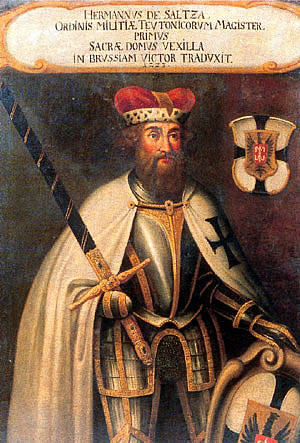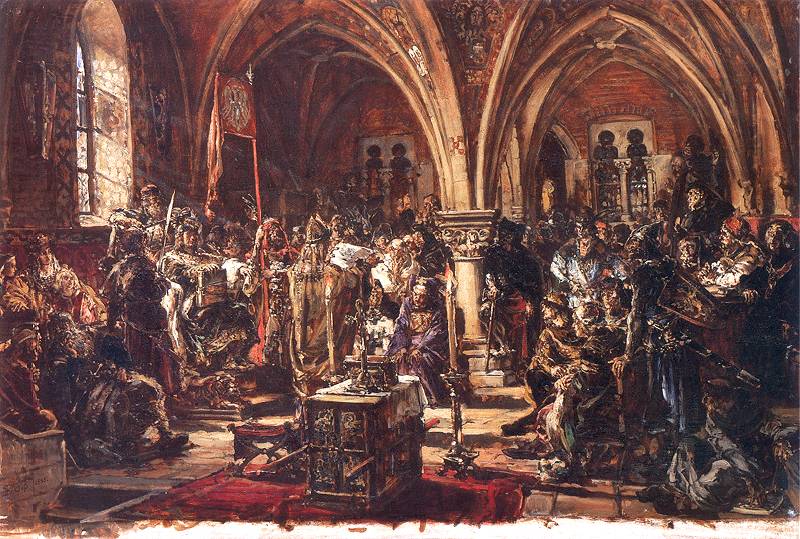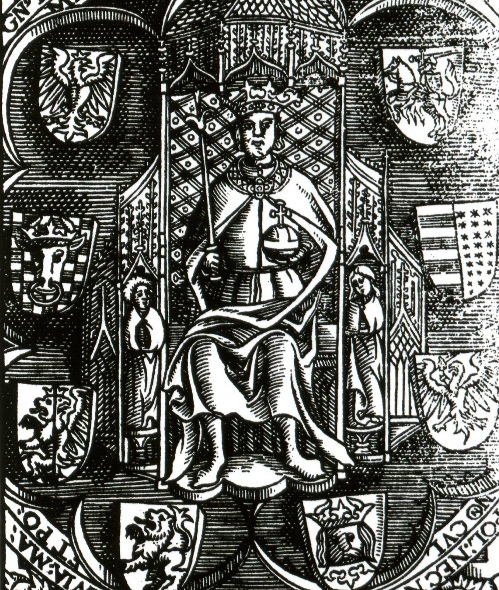|
Heinrich Reuß Von Plauen
Heinrich Reuß von Plauen (died 2 January 1470) was the 32nd Grand Master of the Teutonic Order, serving from 1467 to 1470. He was the nephew of the previous Grand Master, Ludwig von Erlichshausen, and a distant relative to the 27th Grand Master, Heinrich von Plauen. Biography Reuß von Plauen came from the Reuss family from Plauen, Saxony. Incidentally, the family named every male child Heinrich (Henry). Earlier, the brothers Heinrich Reuss von Plauen the Elder and Heinrich Reuss von Plauen the Younger had served in the Thirteen Years' War. Reuß von Plauen joined the Teutonic Order at a young age. He was first a brother in a monastery in Germany. Reuß von Plauen arrived in Prussia in the 1420s when he became the Vogt of Dirschau. In 1433 he became the Komtur of Balga and in 1440 the Vogt of Natangia. From 1441, Reuß von Plauen held the position of the Grand Hospitaller and the Komtur of Elbing (Elbląg). As the Grand Master's nephew, his influence in the Order grew and ... [...More Info...] [...Related Items...] OR: [Wikipedia] [Google] [Baidu] |
Grand Masters Of The Teutonic Knights
The grand master of the Teutonic Order (; ) is the supreme head of the Teutonic Order. It is equivalent to the grand master of other military orders and the superior general in non-military Roman Catholic religious orders. ''Hochmeister'', literally "high master", is only used in reference to the Teutonic Order, as ''Großmeister'' ("grand master") is used in German to refer to the leaders of other orders of knighthood. An early version of the full title in Latin was ''Magister Hospitalis Sanctae Mariae Alemannorum Hierosolymitani''. Since 1216, the full title ''Magister Hospitalis Domus Sanctae Mariae Teutonicorum Hierosolymitani'' ("Master of the Hospital House of the Blessed Virgin Mary of the Germans of Jerusalem") was used. The offices of ''Hochmeister'' and ''Deutschmeister'' (''Magister Germaniae'') were united in 1525. The title of ''Magister Germaniae'' had been introduced in 1219 as the head of the bailiwicks in the Holy Roman Empire, from 1381 also those in Ita ... [...More Info...] [...Related Items...] OR: [Wikipedia] [Google] [Baidu] |
Tczew
Tczew (, formerly ) is a city on the Vistula River in the Pomeranian Voivodeship, in northern Poland, with 59,111 inhabitants (December 2021). It is the capital of Tczew County and the largest city of the ethnocultural region of Kociewie within the historic region of Pomerania. Founded in the Middle Ages with city rights since 1260, Tczew was a major river port on the Vistula, and prospered as a major center for grain trade in Poland. The city is known for its Old Town with medieval Gothic architecture, Gothic churches, and the Vistula bridges, which played a key role in the Invasion of Poland at the onset of World War II. During the war, it was the location of a major German-operated transit camp for Expulsion of Poles by Nazi Germany, Poles expelled from the region, now home to the Vistula River Museum, the main museum devoted to the history of Poland's longest river. Tczew is the largest railroad junction in northern Poland, with railroads towards Gdańsk, Bydgoszcz, Warsaw and ... [...More Info...] [...Related Items...] OR: [Wikipedia] [Google] [Baidu] |
Stroke
Stroke is a medical condition in which poor cerebral circulation, blood flow to a part of the brain causes cell death. There are two main types of stroke: brain ischemia, ischemic, due to lack of blood flow, and intracranial hemorrhage, hemorrhagic, due to bleeding. Both cause parts of the brain to stop functioning properly. Signs and symptoms of stroke may include an hemiplegia, inability to move or feel on one side of the body, receptive aphasia, problems understanding or expressive aphasia, speaking, dizziness, or homonymous hemianopsia, loss of vision to one side. Signs and symptoms often appear soon after the stroke has occurred. If symptoms last less than 24 hours, the stroke is a transient ischemic attack (TIA), also called a mini-stroke. subarachnoid hemorrhage, Hemorrhagic stroke may also be associated with a thunderclap headache, severe headache. The symptoms of stroke can be permanent. Long-term complications may include pneumonia and Urinary incontinence, loss of b ... [...More Info...] [...Related Items...] OR: [Wikipedia] [Google] [Baidu] |
Sejm
The Sejm (), officially known as the Sejm of the Republic of Poland (), is the lower house of the bicameralism, bicameral parliament of Poland. The Sejm has been the highest governing body of the Third Polish Republic since the Polish People's Republic, transition of government in 1989. Along with the upper house of parliament, the Senate of Poland, Senate, it forms the national legislature in Poland known as Parliament of Poland#National Assembly, National Assembly (). The Sejm comprises 460 Member of parliament, deputies (singular or ) elected every four years by Universal suffrage, universal ballot. The Sejm is presided over by a Speaker of parliament, speaker, the "Marshal of the Sejm" (). In the Kingdom of Poland (1385–1569), Kingdom of Poland, the term ''Sejm'' referred to an entire two-Chambers of parliament, chamber parliament, comprising the Chamber of Deputies (), the Senate and the King. It was thus a three-estate parliament. The 1573 Henrician Articles strengthe ... [...More Info...] [...Related Items...] OR: [Wikipedia] [Google] [Baidu] |
Piotrków Trybunalski
Piotrków Trybunalski (; also known by #Etymology, alternative names), often simplified to Piotrków, is a city in central Poland with 71,252 inhabitants (2021). It is the capital of Piotrków County and the second-largest city in the Łódź Voivodeship. Founded in the late Middle Ages, Piotrków was once a Royal city in Poland, royal city and holds an important place in Polish history; the first Sejm of the Polish–Lithuanian Commonwealth, parliament sitting was held here in the 15th century. It then became the seat of a Crown Tribunal, the highest court of the Polish–Lithuanian Commonwealth. The city also hosted one of Poland's oldest History of Jews in Poland, Jewish communities, which was entirely destroyed by the Holocaust. The old town in Piotrków features many historical and architectural monuments, including tenements, churches, synagogues and the medieval Piotrków Trybunalski Castle, Royal Castle. Etymology and other names According to tradition, but not confirmed ... [...More Info...] [...Related Items...] OR: [Wikipedia] [Google] [Baidu] |
Casimir IV Jagiellon
Casimir IV (Casimir Andrew Jagiellon; ; Lithuanian: ; 30 November 1427 – 7 June 1492) was Grand Duke of Lithuania from 1440 and King of Poland from 1447 until his death in 1492. He was one of the most active Polish-Lithuanian rulers; under him, Poland defeated the Teutonic Knights in the Thirteen Years' War and recovered Pomerania. The Jagiellonian dynasty became one of the leading royal houses in Europe. The great triumph of his reign was bringing Prussia under Polish rule. The rule of Casimir corresponded to the age of "new monarchies" in western Europe. By the 15th century, Poland had narrowed the distance separating it from Western Europe and became a significant power in international relations. The demand for raw materials and semi-finished goods stimulated trade, producing a positive balance, and contributed to the growth of crafts and mining in the entire country. He was a recipient of the English Order of the Garter (KG), the highest order of chivalry and the most ... [...More Info...] [...Related Items...] OR: [Wikipedia] [Google] [Baidu] |
Morąg
Morąg (; , ) is a town in northern Poland in Ostróda County in the Warmian-Masurian Voivodeship. It is the seat of Gmina Morąg (commune). Geography The town is situated in the western uplands of the historic Prussia region. Its centre is located about south of the Polish–Russian (Kaliningrad) border. The nearest city is Olsztyn in Warmia, to the southeast. History Middle Ages In medieval times, an Old Prussian settlement existed at the site under the name of ''Mawrin, Maurin'' or ''Morin''. A new town was built on its place by the invading Teutonic Knights after they destroyed the original settlement in the late 13th century. Part of the Order's State, it was given the name ''Mohrungen'' after a nearby lake and in 1327 attained Kulm town law from the local commander (''Komtur'') Hermann von Oettingen. The first inhabitants of the town were emigrants from the southern Harz region in central Germany. After the 1410 Battle of Grunwald the victorious Polish- Lithuanian ... [...More Info...] [...Related Items...] OR: [Wikipedia] [Google] [Baidu] |
Pasłęk
Pasłęk (pronounced ; formerly known in Polish as Holąd Pruski, , Old Prussian: ''Pāistlauks'') is a historic town in northern Poland, within Elbląg County in the Warmian-Masurian Voivodeship. In 2017, the town had 12,298 registered inhabitants. History The oldest record of the name of the Pasłęk territory appears as ''Pozolucensis provincia'' in a petition of Polish Dominicans to Pope Gregory IX from 1231. Later in the 13th and 14th century the settlement was mentioned in documents as ''Pazluch'', ''Pazlok'', ''Paslok''. In 1393 it was mentioned by a ''frater Heinricus de Castro alias Pasloci''. Pasłęk is one of two historic Polish names of the town and it derives from the Old Prussian place name ''Passis Lukis''. The second name is Holąd Pruski. The town in the place of the old settlement was founded by settlers imported from Holland by the Teutonic Order in the late 13th century — hence the name ''Hollant'' or ''Holland'', later changed to ''Preußisch Holland'' ... [...More Info...] [...Related Items...] OR: [Wikipedia] [Google] [Baidu] |
Second Peace Of Thorn
The Peace of Thorn or Toruń of 1466, also known as the Second Peace of Thorn or Toruń (; ), was a peace treaty signed in the Hanseatic city of Thorn (Toruń) on 19 October 1466 between the Polish king Casimir IV Jagiellon and the Teutonic Knights, which ended the Thirteen Years' War, the longest of the Polish–Teutonic Wars. The treaty was signed in the Artus Court, and afterward a mass was held in the Gothic Franciscan Church of the Assumption of the Blessed Virgin Mary to celebrate the peace treaty. Background The treaty concluded the Thirteen Years' War which had begun in February 1454 with the revolt of the Prussian Confederation, led by the cities of Danzig (Gdańsk), Elbing (Elbląg), Kulm (Chełmno) and Toruń, and the Prussian gentry against the rule of the Teutonic Knights in the Monastic State, in order to join the Kingdom of Poland. Both sides agreed to seek confirmation from Pope Paul II and Holy Roman Emperor Frederick III, but the Polish side stressed ... [...More Info...] [...Related Items...] OR: [Wikipedia] [Google] [Baidu] |
Battle Of Chojnice (1454)
The Battle of Chojnice (or Battle of Konitz) occurred on 18 September 1454 near the town of Chojnice, between Poland and the Teutonic Knights during the Thirteen Years' War. The battle was won by the Teutonic Knights. Background The Teutonic army had around 9,000 cavalry and 6,000 infantry under Bernhard von Zinnenberg. The Polish army had 16,000 cavalry, a few thousand servants (who could and usually were used in battles), a few hundred infantry, plus 500 mercenaries and burghers from Gdańsk and 2,000 mercenaries hired by the Prussian Confederacy, all under the command of King Casimir IV, advised by chancellor Jan Koniecpolski and Piotr of Szczekociny. The Polish commanders were counting on the battle being won by the Polish heavy cavalry, not caring much about either artillery or infantry. They had not thought that their opponents could change their traditional strategy, or that the Teutonic soldiers besieged in Chojnice could be anything more than spectators. Bernard ... [...More Info...] [...Related Items...] OR: [Wikipedia] [Google] [Baidu] |
Elbląg
Elbląg (; ; ) is a city in the Warmian-Masurian Voivodeship, in northern Poland, located in the eastern edge of the Żuławy region with 127,390 inhabitants, as of December 2021. It is the capital of Elbląg County. Elbląg is one of the oldest cities in the province. Its history dates back to 1237, when the Teutonic Order constructed their fortified stronghold on the banks of a nearby river. The castle subsequently served as the official seat of the Teutonic Order Masters. Elbląg became part of the Hanseatic League, which contributed much to the city's wealth. Through the Hanseatic League, the city was linked to other major ports like Gdańsk, Lübeck and Amsterdam. Elbląg joined Poland in 1454 and after the defeat of the Teutonic Knights in the Thirteen Years’ War was recognized as part of Poland in 1466. It then flourished and turned into a significant trading point, but its growth was eventually hindered by the Second Northern War and the Swedish Deluge. The city ... [...More Info...] [...Related Items...] OR: [Wikipedia] [Google] [Baidu] |


